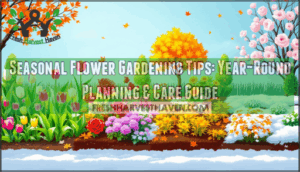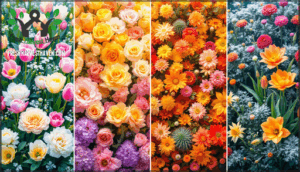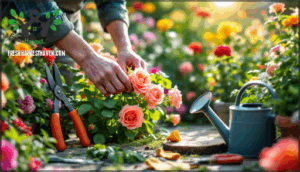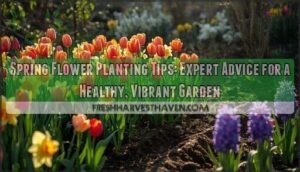This site is supported by our readers. We may earn a commission, at no cost to you, if you purchase through links.

Most gardeners plant with enthusiasm but without timing, treating their beds like they’re immune to weather patterns and growth cycles. Here’s the truth: stunning flower gardens don’t happen by accident.
They’re built on smart seasonal planning, from knowing when to deadhead summer roses to mulching perennials before the first freeze. Master the rhythm of your growing zone, and you’ll swap disappointment for year-round color that actually thrives through every season.
Table Of Contents
- Key Takeaways
- Planning Your Seasonal Flower Garden
- Selecting Flowers for Every Season
- Preparing and Amending Garden Soil
- Essential Flower Garden Maintenance Tips
- Maximizing Bloom and Garden Enjoyment
- Frequently Asked Questions (FAQs)
- What is the gardening 3 year rule?
- How to plant a flower garden for all seasons?
- What is the rule of 3 in gardening?
- What is the best fertilizer for seasonal flowers?
- When should you plant seasonal flowers?
- What month should you start a flower garden?
- How do I layout my flower garden?
- How do you make a flower garden that blooms all year?
- How often do you water seasonal flowers?
- How do I save seeds from my garden flowers?
- Conclusion
Key Takeaways
- Successful year-round flower gardens depend on understanding your USDA hardiness zone and local conditions (sunlight, soil pH, drainage, microclimates) before selecting plants, since even hardy varieties fail in wrong conditions.
- Strategic plant selection combining 60% perennials with 40% annuals creates continuous blooms while reducing long-term costs by up to 70%, with perennials offering better environmental benefits through deep root systems and lower resource needs.
- Succession planting with staggered bloom times—layering early, mid, and late-season varieties within each season—keeps gardens displaying color year-round, while attracting pollinators requires 10+ flowering native species across multiple seasons.
- Proper soil preparation (improving drainage, adding compost/mulch) and consistent maintenance (deep watering 1-2 times weekly, deadheading, seasonal adjustments to fertilizing and frost protection) separate thriving gardens from struggling ones.
Planning Your Seasonal Flower Garden
Starting a flower garden that blooms year-round takes more than just picking pretty plants and hoping for the best. You need a solid plan that takes your climate, garden conditions, and goals into account.
Here’s what you should focus on before you break ground.
Assessing Your USDA Growing Zone
Before diving into plant selection, you need to understand your growing zone using the USDA Plant Hardiness Zone Map. This map divides regions based on average minimum winter temperatures, helping you choose flowers that’ll survive your coldest nights.
The 2023 update uses data from over 13,000 weather stations for improved accuracy. Recent zone shifts mean many areas are now warmer—opening up exciting planting possibilities you couldn’t explore before.
This valuable tool helps gardeners understand average minimum temperatures for plant selection. Keep in mind that microclimates around your property can vary, so local conditions matter too.
Analyzing Sunlight and Soil Conditions
Once you know your zone, the next step is figuring out how much sun your garden gets and what your soil’s actually like—because even the hardiest plants won’t thrive in the wrong conditions.
Start with sunlight mapping—track which spots get full sun (6+ hours), partial shade, or deep shade throughout the day. Then test your soil pH and check soil drainage by digging a hole and watching how quickly water disappears.
Here’s what you’re looking for:
- Soil type: Sandy drains fast; clay holds water
- Sunlight exposure: Morning vs. afternoon sun affects plant choices
- Nutrient deficiencies: Yellowing leaves or stunted growth signal problems
- Drainage solutions: Raised beds help waterlogged areas
- Soil amendments: Compost fixes most issues
Simple tests reveal what needs improving for better soil health.
Choosing an Ideal Garden Location
After you’ve mapped your sun and soil, it’s time to scout the actual spot where your flowers will call home—and believe me, location can make or break your garden’s success.
Look for accessible areas with good sunlight exposure and soil drainage. Check for microclimates—warm pockets near walls or cooler low-lying areas.
Space availability matters too when selecting garden location and preparing flower beds for best garden design.
Creating a Flower Garden Layout
With your perfect spot picked out, it’s time to sketch a layout that keeps taller plants from shading out shorter ones and puts your showstoppers right where you’ll see them every day.
Try common garden layout styles—formal grids, cottage curves, or island beds—and mark focal point placement near entrances or seating areas.
Add paths and borders for easy access, and don’t forget space optimization so you can reach every bloom without trampling neighbors.
Preparing Essential Garden Tools
Before you can coax those first blooms from the soil, you’ll need the right gear in your hands—and the good news is you don’t need much to get started. A sturdy trowel, pruners, and watering can tackle most garden tasks.
Keep your tools sharp and clean between uses—tool maintenance prevents disease spread and makes soil preparation easier. Store them in a dry spot, and they’ll be ready for years of plant care ahead.
Selecting Flowers for Every Season
The right flowers can transform your garden into a year-round showcase, but picking what to plant when makes all the difference. Understanding the basics of annuals, perennials, and bulbs helps you build a garden that keeps delivering color and interest no matter the season.
Let’s look at the key decisions that’ll shape your flower selections and keep your garden blooming strong.
Choosing Annuals Vs. Perennials
Choosing the right plants means understanding how annuals and perennials differ in bloom duration, maintenance needs, and cost comparison. Annuals complete their lifecycle in one season, delivering nonstop color but requiring yearly replanting. Perennials return each year, taking about three years to reach peak performance but offering long-term value—reducing your annual color budget by up to 70% once established. Understanding plant lifecycles is important for effective garden planning.
Consider these key differences for garden design:
- Maintenance: Annuals need frequent watering and fertilizing; perennials require less care after establishment
- Environmental impact: Perennials build soil with deep roots and use fewer resources than annuals
- Upfront investment: Perennials cost roughly double initially but eliminate yearly repurchasing
Using annuals and perennials together creates continuous blooms—annuals fill gaps while perennials provide reliable structure. Most gardeners find success with 60% perennials and 40% annual and perennial flowers combined for balanced seasonal interest throughout the year.
Best Flowers for Spring, Summer, Fall, and Winter
Strategic bloom times transform gardens into rotating showcases of seasonal flowers. Spring blooms like peonies and tulips kick things off—searches for these trending spring blooms jumped 175% and 127% respectively in 2025.
Summer rose varieties and hydrangeas dominate warmer months, while chrysanthemums and asters paint autumn color palettes through fall.
Winter indoor flowers like amaryllis and Christmas cactus keep color alive indoors, with regional flower choices varying by your climate zone.
Incorporating Bulbs, Shrubs, and Vines
Bulbs, shrubs, and vines bring depth and structure to your garden—think of them as the backbone that holds your flower displays together through the seasons.
Spring bulbs like tulips need proper bulb planting depth (usually three times their height), while flowering shrubs require strategic shrub pruning techniques after blooming.
Vining plants like clematis demand sturdy vine support structures and reward you with vertical color when you coordinate bloom time coordination with your seasonal flowers for unified seasonal color mixing.
Selecting Flowers for Continuous Bloom
The secret to a garden that never stops blooming isn’t luck—it’s layering flowers with staggered bloom times so something’s always putting on a show. Mix early, mid, and late-season varieties within each season, and you’ll extend your bloom season effortlessly.
Here’s your continuous-bloom strategy:
- Early bloomers meet late starters: Plant crocuses with asters so spring changes smoothly into fall color.
- Overlap bloom timeframes: Choose reblooming plants like daylilies that flower twice, filling gaps between seasonal flowers.
- Layer texture combinations: Pair delicate cosmos with bold zinnias for visual interest throughout summer.
- Rotate your color palette: Change from cool spring pastels to warm autumn golds naturally.
- Include fragrance profiles: Add scented varieties like sweet alyssum for sensory appeal across your extended bloom season.
Using Color and Height for Visual Impact
Think of your flower garden like a stage production—tall plants are your backdrop, medium ones are your main cast, and short bloomers are the front-row stars that tie everything together. Layered planting with height contrast creates focal points that draw the eye upward.
Use bright colors for visual interest in flower bed designs, mixing texture variety with color harmony to transform simple flower garden design into something memorable.
Preparing and Amending Garden Soil
Your flowers won’t thrive without healthy soil beneath them. Getting your soil right means better drainage, more nutrients, and stronger roots that support steady blooming all season long.
Here’s how to prep your beds and give your plants the foundation they need to flourish.
Improving Drainage and Soil Structure
If your soil drains poorly or feels too heavy for flowers to thrive, you’ll need to work on loosening it up and creating pathways for water to move through. Mixing in organic matter like aged compost or shredded leaves breaks up compaction issues and improves soil structure naturally.
Soil testing helps you understand what your garden soil needs most. You can also create raised beds or mounds to prevent waterlogged conditions and support better drainage solutions.
Using Compost and Mulch for Healthy Growth
Once you’ve improved drainage, compost and mulch become your garden’s best friends for feeding soil and keeping moisture levels steady. Compost benefits your garden soil by adding organic matter that feeds plants slowly over time. Mulch types like shredded bark or straw lock in water retention and provide natural weed control while improving soil conditions underneath.
Here’s what compost and mulch do for you:
- Feed soil microbes that break down nutrients for flower roots
- Reduce watering frequency by holding moisture near plant bases
- Suppress weeds naturally without chemicals or constant pulling
- Regulate soil temperature during hot summers and cold snaps
- Improve texture gradually as organic materials break down
Preparing Planting Beds and Containers
With your soil enriched and protected, it’s time to roll up your sleeves and get those planting beds and containers ready for their starring roles. Start site assessment by clearing debris and loosening compacted areas with a garden fork.
For preparing planting beds, work in bed amendments like compost six inches deep.
Container selection matters—choose pots with drainage solutions like bottom holes. Fill containers with quality potting mix rather than garden soil, since flower soil from the ground gets too dense in confined spaces when you’re amending flower soil for container gardening.
Essential Flower Garden Maintenance Tips
Getting flowers to bloom is one thing—keeping them healthy and thriving is another. Good maintenance makes the difference between a garden that struggles and one that flourishes season after season.
Here’s what you need to focus on to keep your flower garden in top shape all year long.
Watering and Irrigation Techniques
Getting water right can mean the difference between a garden that thrives and one that merely survives. Here’s how to keep your flowers happy:
- Check soil moisture before watering—stick your finger two inches down to test
- Water deeply but less often to encourage strong root growth
- Use drip irrigation systems for water conservation and targeted delivery
- Water early morning to reduce evaporation and prevent disease
Good drainage solutions prevent waterlogged roots, while consistent watering techniques make certain your flowers get what they need when they need it.
Deadheading, Pruning, and Fertilizing
Regular grooming keeps your flowers pumping out blooms instead of wasting energy on spent petals and dead wood. Deadheading techniques are simple—just snip off faded flowers below the bloom. Pruning schedules vary by plant type, but spring and fall work well for most.
Feed annuals with time-released fertilizer for steady bloom production, while perennials need general-purpose plant food to boost soil fertility throughout the growing season.
Controlling Pests and Diseases Naturally
Your best defense against garden pests starts with companion planting. Tansy and catmint can repel beetles with up to 100% effectiveness, while sweet alyssum attracts beneficial wasps that slash aphid numbers.
Biological controls like Trichoderma fungi cut fungal diseases by 42%, and physical barriers such as insect netting keep thrips out without harming pollinators.
IPM techniques recommend natural methods first, saving chemicals for severe infestations. Organic practices protect plant health while supporting a balanced ecosystem.
Protecting Flowers From Frost and Extreme Weather
When temperatures plummet unexpectedly, your tender blooms can go from thriving to toast in a single night—but a few smart protective strategies keep them safe through whatever Mother Nature throws your way.
Cover vulnerable plants with frost blankets or row covers when frost threatens, and mulch heavily around roots for insulation. Windbreak strategies like burlap screens shield winter blooms from drying winds, while weather-resistant flowers naturally withstand extreme conditions better than delicate varieties.
Maintaining a Year-Round Care Schedule
A flower garden isn’t a "set it and forget it" deal—it’s more like tending a friendship that needs regular check-ins throughout the year to truly flourish. Seasonal adjustments keep your garden maintenance schedule on track:
- Spring: Apply fertilizer to seasonal bloomers, test soil health, and monitor emerging pests
- Summer: Adjust watering techniques for flowers during heat waves and deadhead spent blooms
- Fall: Clean and sharpen tools for winter storage, plant bulbs, and add protective mulch
- Winter: Review bloom monitoring notes and plan next year’s pest management strategies
Maximizing Bloom and Garden Enjoyment
Getting your garden to bloom beautifully is only half the story—the real magic comes from making it work harder and smarter for you. With a few strategic tweaks, you can extend those colorful displays, bring in helpful visitors, and turn your space into something you genuinely enjoy every day.
Let’s look at some practical ways to amplify what your flower garden can offer throughout the year.
Succession Planting for Extended Color
Think of succession planting as choreographing a never-ending performance where, as one group of flowers takes its final bow, the next is already waiting in the wings to dazzle your garden.
Staggered planting keeps continuous color flowing through your beds by weaving early, mid, and late-season blooms together.
Your gardening calendar becomes your script—mapping out when to introduce companion flowers at bloom intervals that guarantees one wave flows smoothly into the next, extending the blooming season effortlessly.
Attracting Pollinators and Beneficial Insects
Your garden becomes a bustling pollinator hotspot when you plant native species that bloom across multiple seasons—gardens with 10+ flowering plants support 2.5 times more pollinators than sparse varieties. Floral diversity is your secret weapon for attracting pollinators to garden spaces and building a thriving garden ecosystem.
- Choose begonias and impatiens over pansies—they draw up to 6 times more pollinator visits
- Layer seasonal blooms from early spring through late fall to extend beneficial insect activity by 150 days
- Include native plantings to host 80% more bee species than non-native-only gardens
- Create habitat with permanent herbs like oregano and thyme for winter shelter, boosting survival rates by 65%
- Practice pesticide reduction through integrated pest management—diversified gardens support 30-80% higher densities of helpful predators
Conservation programs have already enhanced pollinator habitat nationwide, but your backyard plays a critical role in flower gardening for pollinators and supporting local ecosystem health.
Using Vertical and Container Gardening
Space-constrained yards and vertical surfaces create opportunities that traditional in-ground beds can’t offer—you can grow thriving flower displays on balconies, patios, and even bare walls.
Container gardening lets you maximize space while adding vertical interest with trellises and hanging baskets. Choose flowering vines like clematis or morning glories for vertical structures, and use quality container soil that drains well.
Strategic plant selection and thoughtful container garden creation deliver stunning aesthetic appeal without requiring acres of land.
Keeping a Garden Journal and Learning From Experience
Recording each season’s wins and mistakes turns your flower beds into a personal textbook that grows more valuable every year. Your garden journal helps smarter garden planning and better seasonal garden care:
- Track bloom times and succession patterns
- Record pest issues and effective treatments
- Note soil amendments and their results
- Document successes/failures with specific varieties
- Reflect yearly trends for flower garden maintenance improvements
Creative Ways to Enjoy Your Flower Garden
Beyond note-taking, your flower garden offers dozens of ways to bring more beauty and joy into everyday life. Cut flower arrangements brighten indoor spaces, while garden photography tips help you capture seasonal beauty. Try floral art projects with pressed blooms, or design creative outdoor entertaining spaces for gatherings. Harvesting flowers for arrangements connects you to nature’s rhythms, and therapeutic gardening benefits extend well beyond the blooms themselves.
| Garden Activity | How to Enjoy It |
|---|---|
| Cut flowers for display | Harvest morning blooms for longest vase life |
| Outdoor living areas | Create flower-framed seating zones for entertaining |
| Nature photography | Document bloom progression and visiting pollinators |
| Pressed flower crafts | Preserve petals in journals, cards, or framed art |
Frequently Asked Questions (FAQs)
What is the gardening 3 year rule?
Perennials often take three years to reach full maturity—first year roots, second year shoots, third year blooms. This rule reminds gardeners that patience pays off when establishing long-term planning for year-round color with seasonal flowers and perennials.
How to plant a flower garden for all seasons?
Start by choosing flowers with staggered bloom seasons—spring bulbs, summer annuals, fall perennials, and winter bloomers.
Layer plants for year-round color while improving soil health and maintaining consistent garden maintenance to get the most from each bloom season.
What is the rule of 3 in gardening?
The rule of 3 in gardening suggests grouping plants in odd numbers—especially threes—for better visual balance and a natural look in your flower bed.
This design principle creates focal points and makes landscape design feel more lively than even-numbered groupings.
What is the best fertilizer for seasonal flowers?
You don’t need expensive designer fertilizers to see impressive blooms. Balanced granular fertilizer works perfectly for most seasonal flowers, applied every 4-6 weeks.
For heavy bloomers, switch to liquid bloom food bi-weekly during peak season.
When should you plant seasonal flowers?
Timing your planting around Best Planting Times guarantees success. Spring and autumn are ideal for most seasonal flowers, considering Regional Climate Impact and Frost Date Awareness.
Check Soil Temperature and plant species approaching their bloom season for vibrant Bloom Timeframes throughout your garden.
What month should you start a flower garden?
In most regions, planting begins in early spring after the last frost dates pass. Climate considerations and regional variations affect timing—warmer zones start earlier, while colder areas delay soil preparation and seed starting until the growing season arrives.
How do I layout my flower garden?
Your layout matters—sketch where tall plants go in back, medium ones in middle, and low growers up front.
Group flowers by color for Visual Harmony, cluster odd numbers together, and leave paths for Accessibility through your flower bed.
How do you make a flower garden that blooms all year?
You don’t need acres of land to achieve year-round interest. Mix seasonal bloomers with extended bloomers, using strategic planting and bloom succession to create continuous color through seasonal rotation of annuals and perennials.
How often do you water seasonal flowers?
Your watering frequency depends on weather, soil type, and plant needs. Most seasonal flowers thrive with deep watering once or twice weekly rather than daily shallow watering.
Check soil moisture two inches down—if it’s dry, it’s time to water.
How do I save seeds from my garden flowers?
Collect seeds from open-pollinated flowers once pods dry and turn brown. Store them in paper envelopes in a cool, dark place.
Test viability by placing a few seeds on damp paper towels to check germination rates before planting next season.
Conclusion
A single forgotten frost date can unravel months of work—that’s how razor-thin the margin is between thriving blooms and crushed dreams. But armed with seasonal flower gardening tips specific to your zone, weather quirks stop being disasters and start becoming manageable blips.
Track bloom times, protect vulnerable plants, and adjust your routine as seasons shift. Your garden won’t just survive the calendar—it’ll steal the show through spring’s first crocus, summer’s peak dahlia explosion, autumn’s golden mums, and winter’s skeletal beauty. That’s the payoff when planning meets passion.











